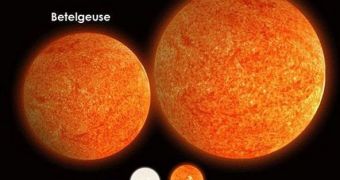For the past few years, rumor had it that the red giant Betelgeuse, one of the largest known stars in the Universe, is about go supernova and implode, potentially forming a neutron star or a black hole. A new investigation shows that this won't happen any time soon.
However, the concerns that the international astronomical community expressed were not unfounded, or based on flimsy suspicions. The star did change shape, which is generally a clear indicator that a supernova is about to take place.
The main reason why what happens to the massive star is important is the fact that it's very close to our planet. At a distance of 640 light-years, it is basically in our backyard, astronomically speaking.
If a supernova does take place, then Earth could be drenched in a massive plume of gamma-rays. This would lead to an extinction-level event (ELE), that would be the seventh in this planet's history.
The distance, the type of supernova, and the direction of emissions are the three most important aspects that we need to consider when assessing the danger we're in from nearby stars reaching the end of their burning cycle.
Some sources say that Earth needs at least 3000 to 6000 light-years (1,000 to 2,000 parsecs) in all directions to be safe from nearby exploding stars. But other studies indicate that even this distance might be insufficient.
A research published some 6 years ago shows that if a star located some 3,200 light-years away would go supernova, then the ensuing gamma-ray burst (GRB) would decimate half of Earth's ozone layer.
This means that more ultraviolet (UV) radiation would reach the surface, damaging DNA, causing mutations, and wrecking havoc among all species. What's even more worrying is that a GRB such as this could take place once every billion year or so.
However, there is no reason to despair, simply because it's not yet clear how a supernova event taking place nearby would affect Earth.
For instance, it may be that clouds of cosmic dust and hydrogen gas exist between us and the exploding star. If so, then the intensity of the radiations would be greatly diminished by phenomena such as Compton scattering and the formation of electron/positron pairs, Science Base reports.

 14 DAY TRIAL //
14 DAY TRIAL //